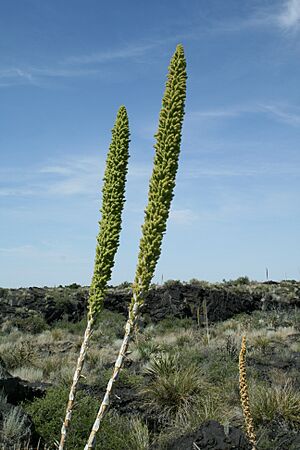Sotol facts for kids
Sotol is a special plant that grows in the Chihuahuan desert in northern Mexico, New Mexico, Arizona, and parts of Texas. It's also the name of a unique drink made from this plant. The sotol plant belongs to the Dasylirion family, and some common types used are Dasylirion wheeleri, Dasylirion durangense, Dasylirion cedrosanum, and Dasylirion leiophyllum. People sometimes call the plant "Desert Spoon" because of how its leaves look.
The sotol drink is very important in Mexico, especially in the states of Chihuahua, Durango, and Coahuila. Since 2002, the official rules say that true sotol drink can only be made in these three states. It's made in a way that's similar to how other famous Mexican drinks like mezcal are produced.
Contents
Ancient Uses of the Sotol Plant
The sotol plant has been super important to people for thousands of years! At a place called the Fate Bell Shelter, which is a big rock opening near the Rio Grande river, you can see pictures of sotol painted on the walls.
People long ago, like the Ancestral Puebloans, used the strong fibers from the sotol plant to make many useful things. They created sandals, baskets, ropes, and mats. These items show how valuable the plant was to them, with some artifacts being as old as 7000 BCE (that's about 9,000 years ago!).
Sotol as Food and Tools
The base of a cooked sotol stem can be eaten, a bit like an artichoke. You scrape the soft part off with your teeth. What's left over looks like a spoon, and people actually used it as one! Archaeologists have found many of these "quids" (the leftover spoon-like pieces) at ancient sites, showing how much sotol was eaten.
The long, straight flower stalks of the sotol plant were also used as parts of hunting tools called atlatl darts. An atlatl is a tool that helps throw a spear farther and faster. Sotol stems were even used to help start fires, acting like a "fireplow" to create friction and heat.
Sotol in Ancient Art
Some ancient rock paintings show a human-like figure with spiky leaves for a head. This figure might represent the magical spirit of the sotol plant. Sometimes, this figure appears with hunting scenes, and other times it's surrounded by orange flames and black smoke, suggesting its connection to fire.
Archaeologists have also found long, shallow troughs in these rock shelters, along with piles of the eaten sotol "quids." This suggests that people were making drinks from sotol as far back as 9,000 years ago. The amazing pictures on the rock walls might be a way to honor how incredibly useful the sotol plant was to these ancient communities.
How Sotol Became a Drink
The native people of Chihuahua, called the Rarámuri, were making a beer-like drink from fermented sotol juice about 800 years ago. Then, in the 1500s, Spanish explorers arrived and brought their own ways of making spirits. They taught people how to distill the sotol juice, which created the stronger sotol drink we know today.
Now, the sotol drink is starting to become famous around the world, just like its cousins, mezcal and tequila.
Making the Sotol Drink
The Desert Spoon plant takes a long time to grow, about 15 years, before it's ready to be harvested. Each plant can only make about one bottle of sotol drink! These plants usually grow on rocky hillsides in the Chihuahuan desert, high up in the mountains.
Unlike agave plants (which are used for tequila and mezcal and only flower once), sotol plants can produce a flower stalk every few years. When a sotol plant is mature, it's harvested in a similar way to agave. The outer leaves are carefully removed to get to the center part, called the "piña" (which means "pineapple" because of its shape).
This "piña" is then taken to a special place called a distillery. There, it can be cooked or steamed, shredded, fermented (which means letting natural yeasts turn its sugars into alcohol), and finally distilled to create the clear sotol spirit.
Types of Sotol Drink
Just like some other aged spirits, sotol can be classified by how long it has been aged:
- Plata – This type is clear and fresh, bottled right after it's distilled. It hasn't been aged at all.
- Reposado – This means "rested." This sotol has been aged for a few months, usually between two months and one year.
- Añejo – This means "aged." This sotol has been aged for at least one year, often in wooden barrels, which gives it a different flavor and color.
Images for kids
See also
 In Spanish: Sotol para niños
In Spanish: Sotol para niños



